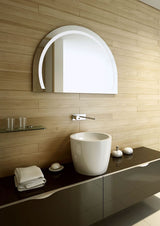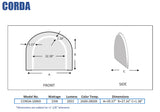

Aamsco Corda ADA Half-Moon LED Backlit Mirror


Aamsco Corda ADA Half-Moon LED Backlit Mirror
$802.77
$537.86



The alluring allure of Aamsco's Corda Backlit mirror lies in its one-of-a-kind design, resembling a captivating half-moon shape that sets it apart in the mirror world. This splendid mirror boasts LED illumination, elegantly ensconced within a slim 1.18" inset band, meticulously tracing the contours of its celestial form. The LEDs' endurance is remarkable, with an impressive lifespan of 30,000 hours, complemented by a stellar Color Rating Index (CRI) exceeding 90. Embodying practicality and inclusivity, this mirror adheres to ADA guidelines and boasts an IP55 rating* while holding an ETL listing. It requires professional hardwiring and comes with an on-off switch, regrettably not featuring dimming capability.
*An IP55 rating signifies that the enclosed equipment is protected from dust and can withstand water splashes and low-pressure water jets, making it relatively resistant to environmental factors.
*An IP55 rating signifies that the enclosed equipment is protected from dust and can withstand water splashes and low-pressure water jets, making it relatively resistant to environmental factors.
Features
- Aamsco's Corda ADA mirror is a backlit LED mirror suitable for the bathroom, or as a decorative mirror in any room of the home or office.
- Corda's half-moon shaped mirror is unique and "mirrored" by a 1.18" thick inset light band illuminated by bright LEDs that follows the contour of the mirror itself.
- The mirror consumes a minuscule 33 Watts and delivers 2055 lumens - plenty. The color temperature is 2,600-2,800 degrees Kelvin, or Warm White with a CRI > 90. Non-dimmable.
- Dimensions are 39.37" Wide x 27.16" High x 1.38" Deep, and held to a tolerence of 0.125". The mirror is surface-mounted and hardwired, requiring a wall-switch.
- Conforms to ADA guidelines, is ETL listed, and IP55 rated (see IP55 Explained). 3-Year manufacturer's warranty.
Aamsco
About Aamsco
 Aamsco, since 1975, has been manufacturing innovative lighting solutions for companies, wordwide. In the suburbs of New York City, their original vintage lighting company was formed by Bob Rosenzweig to manufacture antique light bulbs. With Bob's creativity, Aamsco began expanding and moved to New Jersy, and ultimately in 2001 relocated to Summerville, South Carolina where Aamsco continues to grow to this day.
Aamsco, since 1975, has been manufacturing innovative lighting solutions for companies, wordwide. In the suburbs of New York City, their original vintage lighting company was formed by Bob Rosenzweig to manufacture antique light bulbs. With Bob's creativity, Aamsco began expanding and moved to New Jersy, and ultimately in 2001 relocated to Summerville, South Carolina where Aamsco continues to grow to this day.
IP55 Explained
IP Ratings - Ingress Protection and What it Means
IP Ratings are a classification of the degree of protection against the intrusion of objects including things like hands and fingers, dust, accidental contact, and water. The concept is to provide a more standardized and meaningful set of more specific descriptive terms other than vague marketing lingo, such as "waterproof".
The two digits after the letters "IP" in the rating have separate meanings. The first digit denotes protection against solids. The second digit deals with protection from liquids.
IP55's First digit - 5 - Protection Against Solids
Protection against any large surface of the body, such as the hand, fingers, small objects, tools, most wires, screws, etc, and most dust.
IP55's Second digit - 5 - Protection Against Liquids
Equipment is protected against the ingress of water including dripping water, water from a spray at any angle up to 60 degrees from the vertical, water splashing from any direction, and water from a nozzle (6.3mm) from any direction.
For further information and full ratings charts visit https://en.wikipedia.org/wiki/IP_Code.
3,500k vs. 5,500k
Color Temperature Comparison

Color Temperature is not Brightness Color temperature describes the color of the light.
The color temperature of any light bulb, including LEDs is measured in degrees Kelvin ("k"). The higher the color temperature, the closer the light is to pure white light at 10,000° K. A blue sky sunny day at noon has a color temperature of about 5,500° K. On a very bright cloud-covered day, the sky registers a color temperature closer to white, of about 6,500° K., while a "regular" incandescent light bulb has a color temperature of about 2,700° K.
The color temperature of the lighting in your mirror may affect the way you apply your makeup and then how it's viewed by others, in a real-life situation. It's best, therefore, to choose a lighted makeup mirror with a color temperature to approximate your most frequent environment.
Many of our LED mirrors have their color temperature specified. And some makeup mirrors have adjustable or switchable color temperatures. For those where color temperature is not specified a reasonable guide is this: For incandescent bulbs, a color temperature of around 3,000° K. is normal. LEDs with no color temperature specification often have color temperatures around 4,000° K. The chart at right can serve as a guide.
The color temperature of any light bulb, including LEDs is measured in degrees Kelvin ("k"). The higher the color temperature, the closer the light is to pure white light at 10,000° K. A blue sky sunny day at noon has a color temperature of about 5,500° K. On a very bright cloud-covered day, the sky registers a color temperature closer to white, of about 6,500° K., while a "regular" incandescent light bulb has a color temperature of about 2,700° K.
The color temperature of the lighting in your mirror may affect the way you apply your makeup and then how it's viewed by others, in a real-life situation. It's best, therefore, to choose a lighted makeup mirror with a color temperature to approximate your most frequent environment.
Many of our LED mirrors have their color temperature specified. And some makeup mirrors have adjustable or switchable color temperatures. For those where color temperature is not specified a reasonable guide is this: For incandescent bulbs, a color temperature of around 3,000° K. is normal. LEDs with no color temperature specification often have color temperatures around 4,000° K. The chart at right can serve as a guide.
If you're planning for an outdoor day, the higher the color temperature the better. For evenings on the town, 2,700&deb; K. to 3,500° K. is best. For office environment lighting conditions, color temperatures around 4,500° K. provide the closest match.

About CRI
Color Rendering Index (CRI)

The color rendering index (CRI) is a measure of the ability of a light source to display the colors of various objects faithfully when compared the a natural light source. Light sources with a high CRI value are desirable in color-critical applications such as neonatal care and art restoration. Generally the higher the CRI, the more pleasing to the eye.
The highest possible CRI value is 100 and is frequently achieved by incandescent or "regular" light bulbs. Fluorescent "cool white" bulbs have a CRI of around 50 to 60, but some high-end multi-phosphor fluorescents can go up to 98. LEDs typically have an a CRI around 80, and better, more expensive LEDs can have CRIs up to 97 or 98.
The highest possible CRI value is 100 and is frequently achieved by incandescent or "regular" light bulbs. Fluorescent "cool white" bulbs have a CRI of around 50 to 60, but some high-end multi-phosphor fluorescents can go up to 98. LEDs typically have an a CRI around 80, and better, more expensive LEDs can have CRIs up to 97 or 98.








